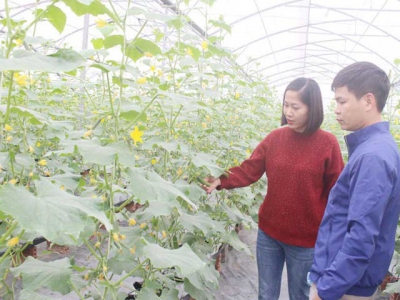Crop restructuring on rice land in Bac Giang: forming many specialized farming areas

Thanks to boldly converting inefficient rice fields into areas cultivating crops of high economic value, localities in Bac Giang province have tapped the advantages of land and climate to develop commodity agriculture, forming many specialized farming areas.
The model of growing baby cucumber in net house is implemented by the Yen Dung Clean Vegetable Cooperative on former rice farming area.
Increasing farmers’ income
Instead of getting up early to go to the field as in previous years, in recent two years, at 7 am, Tran Thi Sinh (born in 1959) in Ca village, My Thai commune (Lang Giang district) and nearly a dozen other farmers in the village are present in the field in front of the village to work.
According to Sinh, previously on an area of nearly 8 ‘sao’ (each ‘sao’ = 360sq.m), her family only cultivated two rice crops per year. With an average yield of 200kg per ‘sao’, she earned nearly 30 million VND (1,297 USD) a year. In early 2019, when the My Thai Clean Vegetable Cooperative was established and brought new varieties into production (vegetables for processing and cucumbers...) on the paddy fields of the village, Sinh and nearly 10 local households lent the cooperative 8 hectares of agricultural land.
Along with the annual rent of 1 million VND (43 USD) per ‘sao’, the households are hired by the cooperative with a wage of 160,000 VND per person per day. “Working for the cooperative, we not only have a stable income, but do not have to worry about crop failures, pests and diseases or market price fluctuations. With my couple's total income (her husband works as a security guard at the cooperative), we have a better life”.
In many localities, by effectively converting the inefficient rice fields into areas growing other crops, the economic value per acreage unit has increased significantly. For example, since it converted 13 hectares of rice to other crops in 2016, the Yen Dung Clean Vegetable Cooperative has expanded its scale to 60 hectares in Tien Dung commune, creating stable jobs and incomes for nearly 100 farmers. According to calculations, the current income in this area has reached 130 million VND (5,620 USD) per ha. In Lan Gioi commune (Tan Yen district), basically the rice farming area in the commune has been covered with baby cucumber, sweet corn and potato, bringing in much higher economic value than that of rice cultivation. Similarly, more than 250 hectares of rice cultivation land in Phuc Hoa commune (Tan Yen) have also been replaced by fruit trees.
Avoiding negative impacts
With the goal of increasing income per acreage unit, in the 2017-2020 period, the province switched nearly 6,400 hectares of rice to annual crops, perennial trees and aquaculture. The formation of concentrated commodity agricultural production areas on rice land is the right direction, bringing in high economic efficiency, contributing to reducing the rate of poor households, increasing income, and tapping the potential and strengths of each locality.
According to the plan, in the 2021-2025 period, Bac Giang will convert 6,100 out of 55,000 hectares of paddy land to annual crops, perennial trees and aquaculture. To well manage crop restructuring on rice land, the provincial Department of Agriculture and Rural Development asked the people's committees of districts and city to direct competent authorities and the people's committees of communes and townships to strictly implement the management of crop restructuring. They must raise the role and responsibilities of heads of government at commune and village levels in directing, guiding and persuading people to engage in agricultural transformation, ensuring compliance with law. Based on the agricultural development planning, plans and orientations, local authorities should proactively devise plans to change the crop structure on rice land for each year, forming concentrated commodity production areas for effective and sustainable production.
According to Tran Van Tu, Deputy Director of the Sub-Department of Cultivation and Plant Protection under the provincial Department of Agriculture and Rural Development, the unit will coordinate with localities to review the converted areas each year, thus putting forth suitable implementation plans. Organizations, households and individuals are only allowed to convert their cultivation land after getting the approval of the communal People's Committee. Localities should intensify the inspection and review of the crop restructuring on rice land to promptly detect and handle violations.
Related news
 Rice production efficiency of eight provinces in Mekong Delta improved
Rice production efficiency of eight provinces in Mekong Delta improved The Ministry of Agriculture and Rural Development (MARD), on March 25 in Tien Giang Province, held a conference to summarize the year 2020
 Vietnam rice rates again on robust demand
Vietnam rice rates again on robust demand Vietnam's rice export prices hit a more than nine-year this week week as fresh orders trickled in.
 Tea exports see bright spot in January-February
Tea exports see bright spot in January-February The Vietnamese tea sector saw positive signs in exports in the first two months of 2021 when shipping 17,000 tonnes abroad and earning 29 million USD